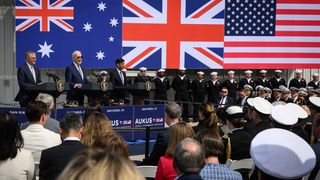The AUKUS submarine announcement earlier this month reignited a long-running debate about how to best preserve Australia’s sovereignty.
The announcement addressed some key concerns. For example, the United States will sell (rather than lease) Australia its Virginia class submarines so Australia can keep these boats. The submarine commanders and crew will be Australian. The rotational deployments of US and UK submarines through Perth won’t become a foreign base. And Australia will ultimately build its own AUKUS class nuclear-powered submarines, likely in Adelaide.
For some commentators, AUKUS is the last nail in the coffin of Australian independence from the United States.
Even so, the AUKUS announcement was met with sharp criticism. For some commentators, AUKUS is the last nail in the coffin of Australian independence from the United States.
There are concerns about the reliance on others for technology and skills, especially regarding the nuclear reactors. Also, the massive investment allocated to the submarines may undermine a more balanced defence force needed for defending the continent.
What’s more, some analysts have questioned whether Australia can maintain independent military decision-making in future conflicts. For example, would Australia’s submarines be used to support the US in a war with China?
These concerns deserve serious consideration.
But many Australian strategists reject them. For them, AUKUS is less revolution than evolution, merely the logical extension of Australia’s robust defence cooperation with the US over many decades.
The AUKUS submarine plan represents a new shade of the dependency that Australia has always had on the US for advanced capabilities, and with which Australia has always been comfortable. So long as Australia is able to use these tools as it sees fit, the argument goes, then sovereignty is ensured. This is the way of the alliance.
We haven’t yet sacrificed our defence sovereignty or sovereign industrial capabilities on the altar of AUKUS.
Here’s why.
What are Australia’s defence sovereignty objectives?
Many critiques of AUKUS go far beyond the specific issue of whether the proposed submarine pathway compromises Australia’s defence sovereignty. Instead, they touch on deeper questions of Australia’s strategic alignment with the US and the UK, and our national decision-making writ large.
For example, the most headline-grabbing critique is that AUKUS has deprived Australia of its freedom to choose what to do in a possible military contingency over Taiwan. But this hinges on a hypothetical future scenario, the answer to which cannot be known today.
If the Virginia class or AUKUS class submarines couldn’t be independently operated and needed US commanders or nuclear technicians, this would undermine our defence sovereignty. But this isn’t the case.
We simply don’t know if Australia is now more locked into a potential US-China conflict than was already the case before September 2021, when AUKUS was first announced.
Answering that question involves far more than an assessment of just our submarine industrial capability.
We should instead judge the submarine announcement, and whether it undermines Australia’s sovereignty, against the actual procurement objectives that lay behind the need to replace the retiring Collins class submarines.
Will the submarine plan help Australia enhance its “defence sovereignty”? And will it help Australia build a “sovereign industrial capability” that gives future governments credible military options at a time of their choosing?
The 2018 Defence Industrial Capability Plan defined “defence sovereignty” as
the ability to independently employ Defence capability or force when and where required to produce the desired military effect.
If the Virginia class or AUKUS class submarines couldn’t be independently operated and needed US commanders or nuclear technicians, this would undermine our defence sovereignty. But this isn’t the case.
Similarly, if a future Australian prime minister wished to send a submarine on a mission and could only do so with US and UK approval and technical support, that would also suggest the government didn’t have full defence sovereignty. But this isn’t the case either.
A century of partnerships with others
The same 2018 capability plan defined a “sovereign industrial capability” as
when Australia assesses it is strategically critical and must therefore have access to, or control over, the essential skills, technology, intellectual property, financial resources and infrastructure as and when required.
In fact, Australia’s domestic defence industrial base has focused on controlling key elements of a capability, rather than manufacturing everything onshore. On the submarines, those will be the components to operate and sustain the boats from Australian shipyards.
Australia has, therefore, chosen to largely equip its defence force with the most advanced capabilities available from abroad – it’s the world’s fourth-largest arms importer for a reason.
It’s worth remembering Australia has never had a truly sovereign submarine industrial capability. The cancelled program with France was but the latest in a century of partnership with others.
This has included:
- jointly crewed boats with the UK before the first world war
- dependence on the US submarine fleet operating from our ports during the second world war
- British-built Oberon submarines in the Cold War
- and Swedish-designed Collins class submarines in the 1990s, incorporating a US combat system and French sensors and radars.
In this sense, AUKUS isn’t a “Brave New World”. It’s more “Back to the Future” for Australia’s shipbuilding aspirations.
AUKUS is a sovereign choice
The dream of an entirely self-sufficient defence industry is inherently appealing. There’s something unsettling about relying on others for capabilities to defend oneself.
The dream of an entirely self-sufficient defence industry is inherently appealing. There’s something unsettling about relying on others for capabilities to defend oneself.
But Australia’s entry into AUKUS doesn’t only entail sovereign risks for Canberra. The US is also making a big bet putting its most closely-guarded nuclear reactor technology and boats in Australian hands at a time when it needs them most.
So what does the US get out of this deal? In 2021, US officials were at pains to reassure us there was no quid-pro-quo to the deal. But even if there were such a request, there’s nothing about AUKUS that locks Australia into actions future governments cannot withdraw from.
The UK received nuclear propulsion technology from the US in 1958 but stayed out of the Vietnam War.
Canada was also offered nuclear-powered submarines in 1988, but chose not to pursue the offer due to budget constraints and public opposition. That backtrack didn’t doom US-Canada relations.
Every day for the next half century, Australia’s leaders will wake up each morning and be free to make a choice about the future of the AUKUS partnership.
So, too, will the Australian people, who at each election will be able to vote for political parties who might offer different visions for the future of AUKUS. That is what it means to be sovereign.






